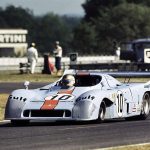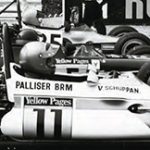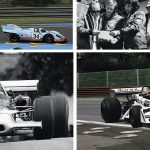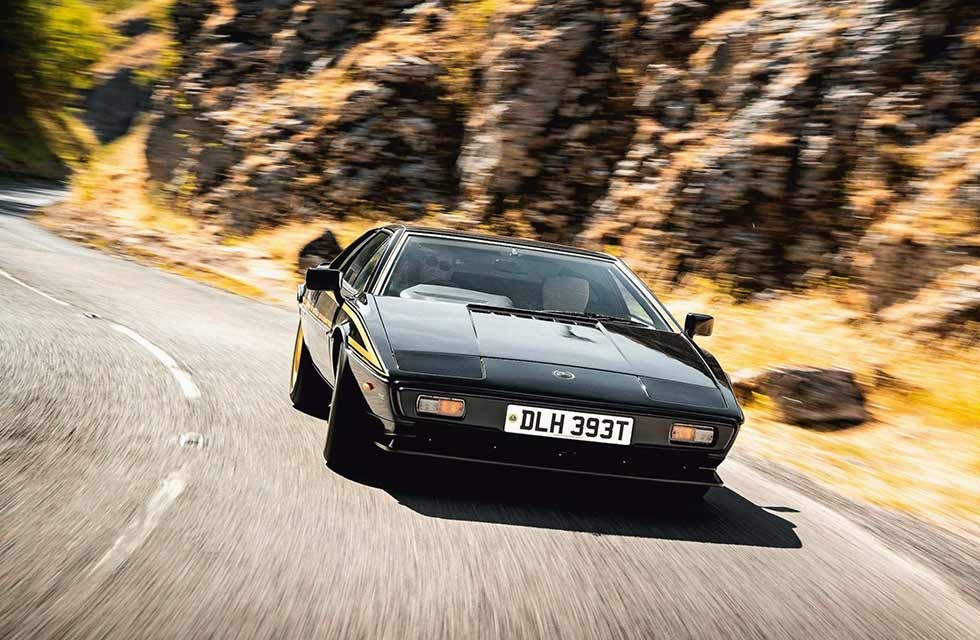
Spirit of a Champion. Commemorating Lotus’ last F1 World Championship, 40 years on, we take the Esprit built in celebration for a drive, then relive a rollercoaster season with Mario Andretti. Words Sam Dawson. Photography Jonathan Fleetwood.
On the road in Lotus’ tribute to F1 greatness – the Esprit Championship Model.
40 years of the last Lotus World Championship
ESPRIT S2 & ANDRETTI ROAD TEST AND INTERVIEW 40 Years of Lotus’ last F1 Championship Reliving the year of Lotus’ final F1 title with a drive in a 1978 Esprit S2 Championship Model. PLUS…
Pride, so the aphorism has it, comes before a fall. But without a sense of pride we wouldn’t celebrate anything. And what better way to commemorate winning the Formula One World Championship, as a manufacturer of both road and racing cars, than to build a special-edition run of your mid-engined sports cars finished in the same eye-catching livery as the victorious racers?
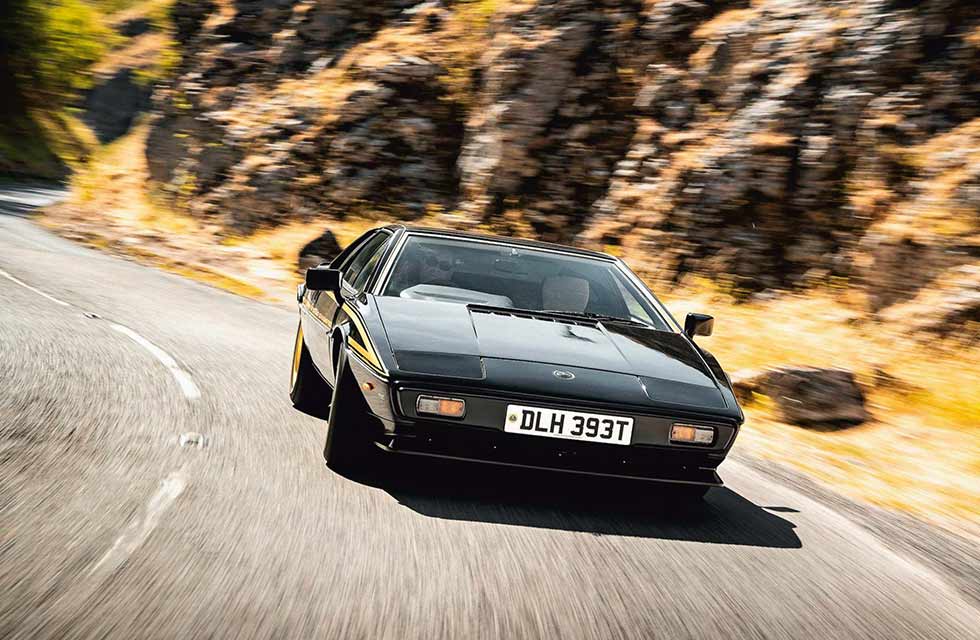
It could be argued that Ferrari does this every time a customer ticks ‘Rosso Corsa’ on the order form, but for others perhaps there’s a sense that to do so would be tempting fate. After all, in October 1978 the Champagne spray was barely dry on Mario Andretti’s racesuit when Lotus unveiled its 99-example Esprit S2 Championship Model. Yet no-one would have bet that the most successful team in Formula One for the previous 20 years would never win the World Championship again. Perhaps the cracks were beginning to show right from the start – ironically, the Esprit couldn’t wear the intended JPS branding from which the colour scheme was derived because Martini stepped in to provide Lotus sponsorship for 1979 just as the car was about to be launched. The official name was World Championship Commemorative Model. Cumbersome.
I meet this Championship Esprit in a very Seventies location. The sheer rock faces and shale-bedded car parks of Cheddar Gorge resemble the kind of quarry setting favoured by poster-photographers and marketing men back then, and in the car’s presence I can see why they liked them. The starkness of the pale rock both complements and accentuates Giorgetto Giugiaro’s uncompromising design. Its radical horizontal lines form a simple, acute-angled arrow that carves an opaque light-sucking slash into nature’s canvas wherever it goes, sun glinting of the gold graphics like the event horizon of a wedge-shaped black hole.
This simple boldness of presentation, coupled with the fact it’s an Esprit S2 – built before oversized bumpers and of-the-shelf BBS split-rim wheels gave the 1981 S3 a clunkier, more productionised look for the bodykit-crazed Eighties – serves as a reminder of how Giugiaro’s design made it from concept to early production relatively unscathed. It’s impractically waist-high, and sports a completely flat trapezoidal windscreen swept by a large single wiper. Things like this were usually rationalised out of supercar design, Lamborghini Countach excepted, even in the Seventies.
Once I’ve negotiated its combination of narrow-opening door, low roof and protuberant seat bolster, I find myself in a snug, comfortable recline in an interior as radical as the body, with its sloping dashboard separating the cabin into faintly aeronautical pods, the binnacle of instruments appearing to float on top of the sloping dashboard. Again, it’s unmolested artist’s-sketchpad stuff, of car interior reimagined as spacecraft cockpit to the point where you ignore all the British Leyland parts-bin fittings.
Two things differ from the standard Esprit S2 though – a three-spoke Momo steering wheel bearing Mario Andretti’s signature, which blocks the voltmeter and fuel gauge completely and obscures the top quartiles of the speedometer and tachometer; and a rubber (rather than wood-topped) gearlever. Both seem incongruously aftermarket until I remember where I’ve seen them before – when peering into the cockpit of Andretti’s old Type 79 Formula One car. Forget the instruments – the wheel is absolutely dead-ahead and perfectly angled for an F1 driver’s straight-armed quarter-to-three grip. The shorter gear lever is at wrist-licking height and an instinctive drop away on the centre-console. The sill-mounted handbrake engages with a single ratchet click. This isn’t sci-fi flamboyance, it’s a stylised racing tub.
The engine takes a while to catch, the whirring of its starter-motor bringing the concept-car dream down to parts-binfurnished, glassfibre-moulded Earth for a moment before the carburettors breathe life into the engine. For something that competed directly with the Maserati Merak and Porsche 911 when new, the Esprit’s four cylinders were sneered at by the motoring press, but this overlooks how exotic its specification was for the time. This was the only production engine available at the time to sport twin overhead camshafts and four-valve cylinder heads. Nowadays it sounds underwhelming because most hot-hatches have this plus fuel injection and turbocharging, but in the Seventies, this was racing technology for the road. Ferrari didn’t follow suit until its V8 Quattrovalvoles a decade later. The slant-blocked engine gives of a deeply percussive timbre at cruising speeds, but there’s sophistication here. I take my first foray towards the Esprit’s torque peak as the bends straighten out at the top of the Gorge and there’s a smooth, if strident-sounding progressiveness, clearly unhindered by excess weight.
Then an extra kick of torque seems to arrive at around 3000rpm and the carburettors’ cackle lattens out into a sibilant whizz. The acceleration never lets up, though – it matches the 150mph Ferrari 308GTB, Maserati Merak, Porsche 911SC and Lamborghini Silhouette almost figure-for-figure for acceleration all the way to 125mph, and even at that point it’s still got more to give. The greater displacement of the Esprit’s rivals saw them better its 137mph top speed. However, I’ll wager few of those Seventies supercar owners ever drove their cars much faster than they could have taken an Esprit anyway.
But what the Esprit does better than all of these cars is make its performance manageable. Its lightness and the racer-style longitudinal mid-engined layout means there’s very little sensation of weight transfer when setting the car up for fast corner attacks. The tiny pedals are closely-spaced but if you come prepared with narrow-soled driving shoes, heel-and-toe downchanges are made easier by the small pedals because there are no broad footpads to clip the edges of.
Unlike the long-winded Ferrari 308, steering even through the Gorge’s narrow hairpins only needs a half-turn of the wheel, hands fixed by the horizontal spokes. And unlike the Porsche 911, there’s barely any sensation of weight transfer in any direction at all, the tyres’ grip unyielding on this bone-dry tarmac. And yet, despite remaining level when cornered hard through second-gear bends, there’s no skittishness. The trademark Lotus long-travel damping produces a ride that could almost be described as luxurious.
As the Esprit plunges deeper into the Gorge, I realise something slightly odd for a performance car. Not once have I glanced at the speedo. Admittedly the Championship Model’s steering wheel makes this difficult, but there’s more to it than that. This car isn’t about hitting impressive figures on dials – although it will crack 138mph, accompanied by a racetrack scream – but rather the tactile delight of total-involvement driving. The gearbox, the same Citroën SM unit as a Maserati Merak’s but with a shorter throw to the lever, has a beautifully positive movement with just enough weight to prompt committed actions. It must have been a revelation to a serial Lotus customer coming from the marque’s previous F1-inspired mid-engined celebration, the 1972 Europa Special, which sported one of the most convoluted linkages, and unpleasantly imprecise gearchange actions, ever known on a Seventies machine.
The Esprit’s steering setup, too, must be one of the most communicative ever fitted to a road car. Through its chunky-rimmed wheel, it transmits everything the front tyres encounter straight into your palms with millimetric precision in a manner that makes even the Porsche 911 feel numb. And yet, perhaps this is its one undoing? Piling into a third-gear left-hander, the front wheels hit some rutted, subsiding tarmac. The lively fizz of the wheelrim suddenly becomes violent overload, the issures in the road surface trying to claw the chunky wheel from my hands. The solution to this issue is to believe in the grip of the tyres, hold the wheel firm and trust the car to remain faithful to its line, such is the composure of the chassis.
Truth be told, hyperactive steering isn’t the Esprit’s only shortcoming. It’s noisy at cruising speeds, giving of a constant gravelly gargle that sounds fantastic when you’re hurtling around country lanes, but must get tiresome when you fancy listening to a radio that cost a hefty £76 in 1978. The Countach-like lines of the bodywork generate Lamborghini visibility issues too – although the sides of the car are easy to position on the road, the base of the windscreen is the forwardmost point of the car you can see from behind the wheel unless you pop the headlamps up. Rear three-quarter visibility is dominated by massive C-pillars and the protruding engine-bay air scoops added as part of the S2 revisions to cure the original Esprit’s overheating issues.
Still, no one complains about such things on an Italian supercar following a drive in one. Instead, they wax lyrical about a sense of glorious irrationality, exploding with superlatives about the sense of style, excitement and motor sport breeding. Uncritical, gushing praise for Ferrari, combined with lingering-glance photography, has generated an entire coffee-table book industry. And yet, having driven this Esprit Championship Model, I feel exactly the same way about it. It’s every bit the thoroughbred its contemporary Ferrari 512BB was. It just goes about it in a uniquely British way that we Brits are stereotypically dismissive off.
The 512BB takes its lead from Italian motor sport practice, with an aluminium body over a combination of tubular chassis and semi-monocoque glassfibre tub, and an engine with its origins in Ferrari’s Formula One programme. It was intended be the closest thing to driving a 512S sports-racer on the road.
The Esprit does the same thing, but draws upon British garagiste racing practice. The original Esprit hit the road the same year as the uniquely British S2000 class of sports-racers burst onto the Brands Hatch tarmac for the first time, their glassfibre bodies sitting on steel chassis, weight and drag kept low to extract maximum performance from a 2.0-litre engine. Those twin camshafts and four-valve cylinder heads resembled those of a Cosworth DFV, the engine with 12 F1 World Championships to its name. In an era when Tyrrell, Brabham, Williams and McLaren didn’t build road cars, it felt as though the Esprit represented the nation’s entire motor sport industry in the international supercar arena.
But it’s the way the Esprit handles that confirms it as a truly British supercar. Whereas Ferraris seem born for the rapid straights of Monza, and Porsches are designed in the tradition of the rear-engined autobahn stromlinien of the Thirties, remaining planted high on the banking at Avus, the Esprit is designed for intense bursts of high performance on a small, crowded island with expensive petrol. Its home would be the bounding switchbacks of Cadwell or Oulton – or your favourite complex of country lanes. The ones you head for when the motorway’s at a tedious crawl.
Lotus still makes cars like this Esprit. However, it’s this model’s nicotine-stained clothes – and the era it was created in – which makes it truly special. It marks Lotus at its absolute zenith – Chapman at the helm pioneering ground-effect, Andretti as World Champion, more Formula One Constructor’s Championship titles in the trophy cabinet than any other team, James Bond eschewing his traditional Aston Martin for an Esprit and an impressive rollcall of celebrities queuing up to buy an Elite. It’s an intoxicating combination that Ferrari, Maserati and Porsche struggled to counter in 1978, and one that no amount of be-stickered special-edition Elises will ever recapture. What Lotus wouldn’t give to stay in that moment for ever.
TECHNICAL DATA FILE SPECIFICATIONS 1978 Lotus Esprit S2 Championship Model
Engine 1973cc in-line four-cylinder, dohc, two Dell’Orto DHLA 45E twinchoke carburettors
Max Power 160bhp @ 6200rpm / DIN
Max Torque 140lb ft @ 4900rpm / DIN
Transmission Five-speed manual, rear-wheel drive
Suspension Front: independent, unequal-length wishbones, coil springs, telescopic dampers, anti-roll bar. Rear: independent, lower transverse links, fixed-length driveshafts, semi-trailing arms, coil springs, telescopic dampers
Brakes Discs front and rear
Steering Rack and pinion
Weight 1022kg
Performance Top speed: 138mph; 0-60mph: 6.8sec
Fuel consumption 20mpg
Price new £11,754
Classic Cars Price Guide £30,000-£65,000
‘It transmits everything the front tyres encounter in a manner that makes even the Porsche 911 feel numb’
A very British riposte to what Ferrari, Porsche and Maserati had to offer. Humble cylinder count, but four valves per cylinder. Just 99 cars were built, with the first going to Mario Andretti. No advertising legislation breaches to be found here. Colour scheme aside, the World Championship Commemorative Model was restrained in comparison to the S3 that followed – or indeed the bewinged F1 cars to which it owed its existence. Sam finds the steering almost too communicative Cumbersome name, capable nature Andretti-signed wheel is a special-edition preserve Rubber-clad shift knob in place of wood.
‘This isn’t sci-fi flamboyance, it’s a stylised racing tub’
OWNER’S VIEW
‘I’m only its third owner,’ says André Navarra of the Championship Model S2 he bought 15 months ago. ‘The person before me had it four years, but the guy before him owned it for 27. You’re always better of knowing all about an Esprit’s ownership history. I haven’t had to do much work, but I’ve had the engine rebuilt and parts of the interior retrimmed – it smelt old and musty and the leather on the dashboard was lifting. It was important to save the original seats because you can’t get new material.
‘I’ve always wanted one – I had a black Esprit back in 1983 when I was 28 and stuck JPS decals on it. It was a three-year-old S2, but they always depreciated steeply, especially once the S3 had come out. I sold that car and moved on, but I’m glad I came back to an Esprit. My son won’t let me sell it now – he says it reminds him of Star Wars!
‘SJ Sportscars in Crediton balanced and rebuilt the engine. A complete restoration, rebuild and repaint of an S1 can cost £100k, so a well looked-after S2 is an absolute bargain by comparison.’
BUYING AN EARLY ESPRIT
‘What you’ve got to remember about Esprits – especially pre-S3 – is that they aren’t budget cars,’ says Paul Matty, Lotus specialist of four decades. ‘They’re very expensive to restore, £70k-£100k to do it properly. The best S2 will cost £60k-£65k. Average ones are £40k-£45k, but £15k-£30k is uneconomical project territory.
‘Start with the chassis, get it on a ramp and check it for corrosion. If it’s rusted you won’t just need a chassis, you’ll need to replace the inboard brakes, suspension, bushes, radiator, fans and coolant pipes too, taking you to £20k already. And those pipes are an engine-out job. ‘Other engine-out jobs include clutch replacement and new fuel tanks. All these jobs take between eight and 12 hours, at £75 per hour.
Parts availability is an issue too, especially for the Maserati gearbox. ‘Painting requires all body panels to be removed and the glass needs to come out – it’s bonded in and usually cracks during removal, so add another £1000 to the £7k job. ‘The engine can be fragile and not serviced properly because of its mid-mounted location and difficult cooling system. A rebuild costs £7k-£9k depending on how many old-stock parts need sourcing – replacement cylinder heads or exhaust manifolds aren’t available.
Mario Andretti The 1978 F1 World Champion relives the year at Lotus, from the marque’s tragic and turbulent last winning season to his own special Esprit.
A Champion’s Year
The Lotus Esprit Championship Model was built to honour Mario Andretti. Here, he recalls a year of triumph and tragedy – and his ownership of ‘Number One’. Words Sam Dawson. Photography Getty Images.
‘The Esprit? That was fun – one of the nice perks of winning the Formula One World Championship!’ Mario Andretti chuckles as he recalls taking delivery of the first Championship Model in October 1978. ‘It was an attractive road car – Colin Chapman was a generous man. It wasn’t the first time he’d given me a car actually – even before I drove for him, when he was trying to secure my services for 1975, he sent me an Elan, which was great to drive and very unusual in the US. ‘But that Esprit S2, especially after winning the championship, I simply loved. I tooled around in it for a couple of years, feeling proud rather than self-conscious of the World Champion decals on the doors. It represented what we’d achieved as a team that year. And then I gave it to my son Michael as his first car – he used to drive to High School in it! Everyone at the school was very envious of it, but I got a lot of satisfaction out of that, seeing everyone’s eyes on that unique car. To be honest, I love to show of! Mine was different to the others too – it had special wheels made by Speedline, wider than usual at the rear so it could wear bigger, grippier tyres.
‘Although I only raced for Colin, he knew how much I loved road cars – it’s not just about racing with me, I’m just a car guy, period – and would always tell me excitedly about what he was working on. He’d often talk about getting me over to Hethel to test out the road cars, maybe do some development work with him, but my biggest problem back then was that I was active over here in the US in IndyCar at the same time I was racing in F1, and I just didn’t have the time to do test-driving. It would have been fun though – and Colin always had a road car standing by for me to use during the European F1 season.
‘And that 1978 championship? It was a tough year. As you can see from any pictures of the cars on the grid, the engineers back then were open to many more ideas, exploring previously unknown aspects of performance design. You could do an awful lot to the car and still be within the rules, so we had six-wheeled Tyrrells and Marches, turbocharged Renaults, ground effect on the Lotus, but the car we were most concerned about was the Brabham. We’d struggled to keep ahead of their Alfa Romeo lat-12s in 1977, and of course partway through the season they unveiled their Chaparral-style BT46B fan-car.
‘It was a fascinating time to be an F1 driver, with so many incredible designs, and engineers constantly looking outside the envelope. Being a driver during the of-season was like being an expectant father, waiting for a child to be born, but wondering whether it would have three eyes! But it was a good anxiety.
‘The Lotus Type 79 wasn’t the superior slam-dunk people think it was, and took a long time to get right. Ground effect was beneicial, but we struggled to get the right shape and size for the frontal area of the car. At the start of the season we were still using the previous season’s Type 78, so early successes were down to Colin Chapman’s skill in setting up the car. He never rested, always looking for something different, whatever unfair advantage he could find. That’s why every driver on the grid wanted to work for Colin.
‘I think FISA allowed Lotus to keep ground effect while it banned nearly everything else because it was fundamentally simple. It achieved downforce only using aerodynamic surfaces, wings and the structure of the car itself, with no moving parts, and its effects could be easily limited with a rear diffuser.
‘By contrast, that Brabham fan car was dangerous. I found myself following it when it was leading the Swedish Grand Prix at Anderstorp, and I don’t think I had enough protective shielding to withstand an entire race behind one! The way it worked, it sucked every loose pebble and piece of grit of the road surface and shot it out of the back. It had a very negative effect on the race and FISA was right to regulate it out of the sport. But all credit to Gordon Murray – and Jim Hall, who invented the technology – for trying. Things like the BT46B kept other drivers and teams motivated.
Cadillac, Ferrari and Lotus in the Andretti garage. Main image: Andretti completes his move on Villeneuve at the fateful 1978 Italian GP at Monza. Left, top to bottom: taking the Type 79 to a maiden victory at Zolder; an intense conversation with Chapman at Watkins Glen; his last race in the Type 78 at Monaco. Despite winning the World Championship, 1978 was a difficult year for Mario Andretti.
‘When we were still using the 1977-season car at the beginning of the 1978 season, it was still competitive. It was actually the norm in those days to start the season, the South American and African races, with last year’s car, then reveal the new cars for the European season. But that 1977 Type 78 made me anxious, because we’d struggled to get competitive power from our Cosworth DFV, and tuning it for higher output made it unreliable – to win, you need to finish!
‘When we arrived at Zolder for the Belgian Grand Prix, I knew about a new car that Ronnie Peterson and chief engineer Bob Dance had been developing – they’d kept me updated over the phone – but I’d had racing commitments in the US and couldn’t make the test at Anderstorp. I was meant to be driving the old 78 at Zolder, but Colin brought this new 79 along as well. I knew it’d be something special, so I said to Colin “this looks really good!” ‘Colin replied, “Yes, but this is just a test car. We know what we have with the 78.” I asked him for a practice drive in it all the same, and he reluctantly agreed. Immediately, I was posting the quickest times of the day. I went back to Colin and told him I wanted to drive it in the Grand Prix. He said, “no, it’s not ready.”
So then I went to Bob and his team of mechanics and asked if it could be made raceworthy in time for qualifying. Bob said, “We can prepare it by tomorrow.” I went out, took pole position and won immediately. That attitude was typical of Colin. He’d push people into expressing themselves in order to get the best out of them. Deep down, he wanted to win just like the rest of us. ‘But when we were ahead, as we were fairly early on in 1978, I was always a bit concerned about Colin’s experimentalism – tinkering with the DFV is what cost us the 1977 championship, after all. We had issues with the rear brakes too – they were inboard, so we could keep the ground-effect diffuser exits clear, and Colin had Hewland cast half the calipers into the gearbox housing. This would boil the brakes, and on any track that involved a full tank of fuel at the start, we had to pump the brakes on the straights to avoid any hard braking near the corners.
‘Midway through 1978, Colin came up with this clutchless sequential-manual gearbox; I told him, “I’m leading. If you must, put it on Ronnie’s car. If I’m winning, let’s try to keep winning.” In the end he dropped the idea after one race.’
Andretti’s voice wavers a little whenever he mentions the late Ronnie Peterson. ‘We were very close friends, more like brothers,’ he recalls. ‘I’d known him since my early days in F1, when we were racing for different teams – I was with Ferrari and he was at March at the time. We had a very similar sense of humour, and our families would go to each others’ houses – his to the US, mine to Sweden – for summer holidays. He was responsible for the closest, most memorable race I had that season.
‘It was the Dutch Grand Prix at Zandvoort. One of my exhausts broke, bending the rear diffuser, causing me to lose the downforce from my right-hand sidepod. It made for a real grip deficit on the flat right-hander at Bos Uit, coming on to the main straight, which was the best overtaking opportunity on the track. Ronnie was right on my tail, and fought so hard all the way through the race, threatening to come past me coming into Tarzan for lap after lap. I had to resort to chopping him up pretty badly in order to stop him overtaking, which was difficult to do to a friend, and which made what happened at Monza two weeks later feel so much worse.’ Andretti still refers to that race as ‘the Italian Grand Prix disaster’. A seven-car pile-up on the packed grid snapped Peterson’s Lotus in two. James Hunt, Patrick Depailler and Clay Regazzoni heroically pulled Peterson, his legs shattered, from the blazing wreckage, and he was airlifted to hospital. Andretti took pole for the restart, his mind now on his friend as well as the title he was set to clinch.
‘Usually, the red lights stay on for ten seconds before the green light comes on,’ states Andretti, still notably irked by what happened next. ‘With the red lights still on, Gilles Villeneuve, who was in second place alongside me on the grid, just took off. He was at the Rettiilo chicane before I decided to set of, figuring there must be something wrong with the lights. It took the whole race to hunt him down, before I finally overtook him coming into Ascari a few laps from the end.
‘And of course they penalised both of us. I was going to protest, but after what had happened to Ronnie I just didn’t have the energy. By the time we got to Monza the only person who could mathematically have beaten me was Ronnie. We should have celebrated that day, but loss overcame joy.’
Peterson died in hospital the next day, from complications related to his leg surgery.
Andretti reflects upon another lost friend too, one whose death four years later, he feels, is ultimately responsible for Team Lotus’ fall from F1 grace. ‘Colin Chapman was the ultimate motivator, who would arm himself with the best technology and people,’ he says. ‘He was the catalyst that created all those great cars, the driving force that made everything happen. Just to hear him reasoning decisions – out loud – was a special thing to witness. He was all about excelling, winning, and never being complacent. Without Colin, Team Lotus lost all that.’
‘Just to hear Chapman reasoning his decisions – out loud – was a special thing to witness. He was never complacent’


